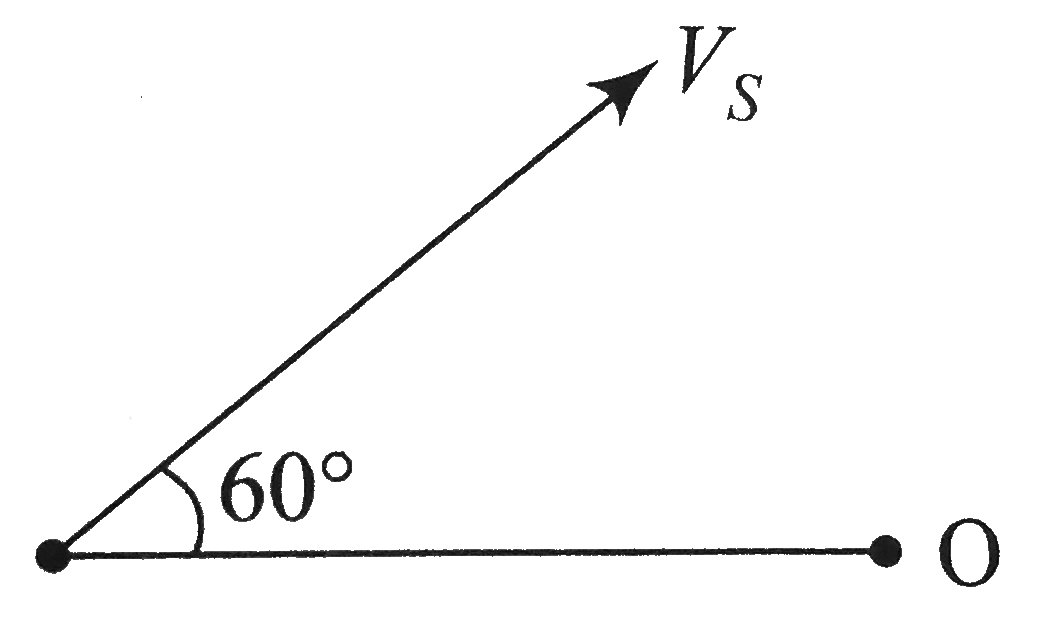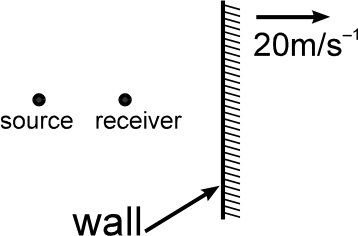A source S of sound wave of fixed frequency N and an observer O are located in air initially at the space points A and B, a fixed distance apart. State in which of the following cases, the observer will NOT see any Doppler effect and will receive the same frequency N as produced by the source.
Both the source S and observer O remain stationary but a wind blows with a constant speed in an arbitrary direction.
The observer remains stationary but the source S moves parallel to and in the same direction and with the same speed as the wind.
The source remains stationary but the observer and the wind have the same speed away from the source.
The source and the observer move directly against the wind but both with the same speed.
The correct Answer is:A, D
To determine in which case the observer will not experience any Doppler effect and will receive the same frequency N as produced by the source S, we can analyze each scenario based on the principles of the Doppler effect.
1. Understanding the Doppler Effect:
The Doppler effect describes the change in frequency of a wave in relation to an observer moving relative to the wave source. The formula for the apparent frequency f′ is given by:
f′=f(v+vov+vs)
where:
- f = actual frequency of the source
- v = speed of sound in the medium
- vo = speed of the observer (positive if moving towards the source)
- vs = speed of the source (positive if moving away from the observer)
2. Case Analysis:
- Case 1: Both the source and observer are stationary, but wind blows with a constant speed in an arbitrary direction.
- Here, vo=0 and vs=0. The wind does not affect the frequency received by the observer since the speeds in the numerator and denominator will be equal. Thus, f′=f. No Doppler effect.
- Case 2: The observer remains stationary, but the source moves parallel and in the same direction as the wind.
- In this scenario, the source is moving, so vs≠0 while vo=0. The observer will perceive a different frequency due to the motion of the source. Doppler effect occurs.
- Case 3: The source is stationary, but the observer and the wind have the same speed moving away from the source.
- Here, vs=0 and vo≠0. The observer will perceive a different frequency because the observer is moving away from the stationary source. Doppler effect occurs.
- Case 4: Both the source and observer move directly against the wind, but both with the same speed.
- In this case, both the source and observer are moving with the same speed, resulting in no relative motion between them. Thus, vo=vs and the relative velocities cancel out, leading to f′=f. No Doppler effect.
3. Conclusion:
The observer will not see any Doppler effect and will receive the same frequency N in Case 1 and Case 4.
Final Answer:
The observer will NOT see any Doppler effect and will receive the same frequency N in:
- Case 1: Both the source and observer are stationary, but wind blows with a constant speed in an arbitrary direction.
- Case 4: Both the source and observer move directly against the wind, but both with the same speed.
The Doppler effect describes the change in frequency of a wave in relation to an observer moving relative to the wave source. The formula for the apparent frequency f′ is given by:
f′=f(v+vov+vs)
where:
- f = actual frequency of the source
- v = speed of sound in the medium
- vo = speed of the observer (positive if moving towards the source)
- vs = speed of the source (positive if moving away from the observer)
- Case 1: Both the source and observer are stationary, but wind blows with a constant speed in an arbitrary direction.
- Here, vo=0 and vs=0. The wind does not affect the frequency received by the observer since the speeds in the numerator and denominator will be equal. Thus, f′=f. No Doppler effect.
- Case 2: The observer remains stationary, but the source moves parallel and in the same direction as the wind.
- In this scenario, the source is moving, so vs≠0 while vo=0. The observer will perceive a different frequency due to the motion of the source. Doppler effect occurs.
- Case 3: The source is stationary, but the observer and the wind have the same speed moving away from the source.
- Here, vs=0 and vo≠0. The observer will perceive a different frequency because the observer is moving away from the stationary source. Doppler effect occurs.
- Case 4: Both the source and observer move directly against the wind, but both with the same speed.
- In this case, both the source and observer are moving with the same speed, resulting in no relative motion between them. Thus, vo=vs and the relative velocities cancel out, leading to f′=f. No Doppler effect.
The observer will not see any Doppler effect and will receive the same frequency N in Case 1 and Case 4.
The observer will NOT see any Doppler effect and will receive the same frequency N in:
- Case 1: Both the source and observer are stationary, but wind blows with a constant speed in an arbitrary direction.
- Case 4: Both the source and observer move directly against the wind, but both with the same speed.
Topper's Solved these Questions
- BOOK - CENGAGE PHYSICS ENGLISHCHAPTER - SOUND WAVES AND DOPPLER EFFECTEXERCISE - Assertion-Reasoning24videos
SOUND WAVES AND DOPPLER EFFECT
- BOOK - CENGAGE PHYSICS ENGLISHCHAPTER - SOUND WAVES AND DOPPLER EFFECTEXERCISE - Comprehension144videos
SOUND WAVES AND DOPPLER EFFECT
- BOOK - CENGAGE PHYSICS ENGLISHCHAPTER - SOUND WAVES AND DOPPLER EFFECTEXERCISE - Single Correct252videos
SOUND WAVES AND DOPPLER EFFECT
- BOOK - CENGAGE PHYSICS ENGLISHCHAPTER - RIGID BODY DYNAMICS 2EXERCISE - Interger2videos
RIGID BODY DYNAMICS 2
- BOOK - CENGAGE PHYSICS ENGLISHCHAPTER - SUPERPOSITION AND STANDING WAVESEXERCISE - Comprehension Type5videos
SUPERPOSITION AND STANDING WAVES
Similar Questions

A source of sound S emitting waves of frequency 100Hz and an observer O are located at some distance from each other. The source is moving with a speed of 19.4ms−1 at an angle of 60∘ with the source observer line as shown in the figure. The observer is at rest. The apparent frequency observed by the observer (velocity of sound in air 330ms−1) isView SolutionWhen both the listener and source are moving towards each other, then which of the following is true regarding frequency and wavelength of wave observed by the observer?
View SolutionA source of sound of frequency 300 Hz and a receiver are located along the same line normal to the wall as shown in the figure. Both the source and the receiver are stationary and the wall receeds from the source with velocity 20ms−1.If the beat frequency registered by the receiver is 240x Hz then x is :
(Assume Vsound=300 m/s).
 View Solution
View SolutionA source S of acoustic wave of the frequency v0=1700Hz and a receiver R are located at the same point. At the instant t=0, the source start from rest to move away from the receiver with a constant acceleration ω. The velocity of sound in air is v=340ms.
If ω=10ms2 for 10s and then ω=0 for t>10s, the apparent frequency recorded by the receiver at t=15sView SolutionA source S of acoustic wave of the frequency v0=1700Hz and a receiver R are located at the same point. At the instant t=0, the source start from rest to move away from the receiver with a constant acceleration ω. The velocity of sound in air is v=340ms.
If ω=10ms2 for 10s and then ω=0 for t>10s, the apparent frequency recorded by the receiver at t=15sView SolutionA source of sonic oscillations with frequency n=1700Hz and a receiver are located on the same normal to a wall. Both the source and receiver are stationary, and the wall recedes from the source with velocity u=6.0ms. Find the beat frequency registered by the receiver. The velocity of sound is v=340ms.
View SolutionA source of sonic oscillations with frequency n=1700Hz and a receiver are located on the same normal to a wall. Both the source and receiver are stationary, and the wall recedes from the source with velocity u=6.0ms. Find the beat frequency registered by the receiver. The velocity of sound is v=340ms.
View SolutionConsider two sound sources S1 and S2 having same frequency 100Hz and the observer O located between them as shown in the fig. All the three are moving with same velocity in same direction. The beat frequency of the observer is
 View Solution
View SolutionA source S of acoustic wave of the frequency v0=1700Hz and a receiver R are located at the same point. At the instant t=0, the source start from rest to move away from the receiver with a constant acceleration ω. The velocity of sound in air is v=340ms.
Q. If ω=10ms2, the apparent frequency that will be recorded by the stationary receiver at t=10s will beView SolutionA source of sound and an observer are approaching each other with the same speed, which is equal to (110) times the speed of sound. The apparent relative change in frequency of source is
View Solution

